7 Oct 2024
Breaking Barriers: The Role of Virtual Reality in Medical Training Diversity
Shaun Bell
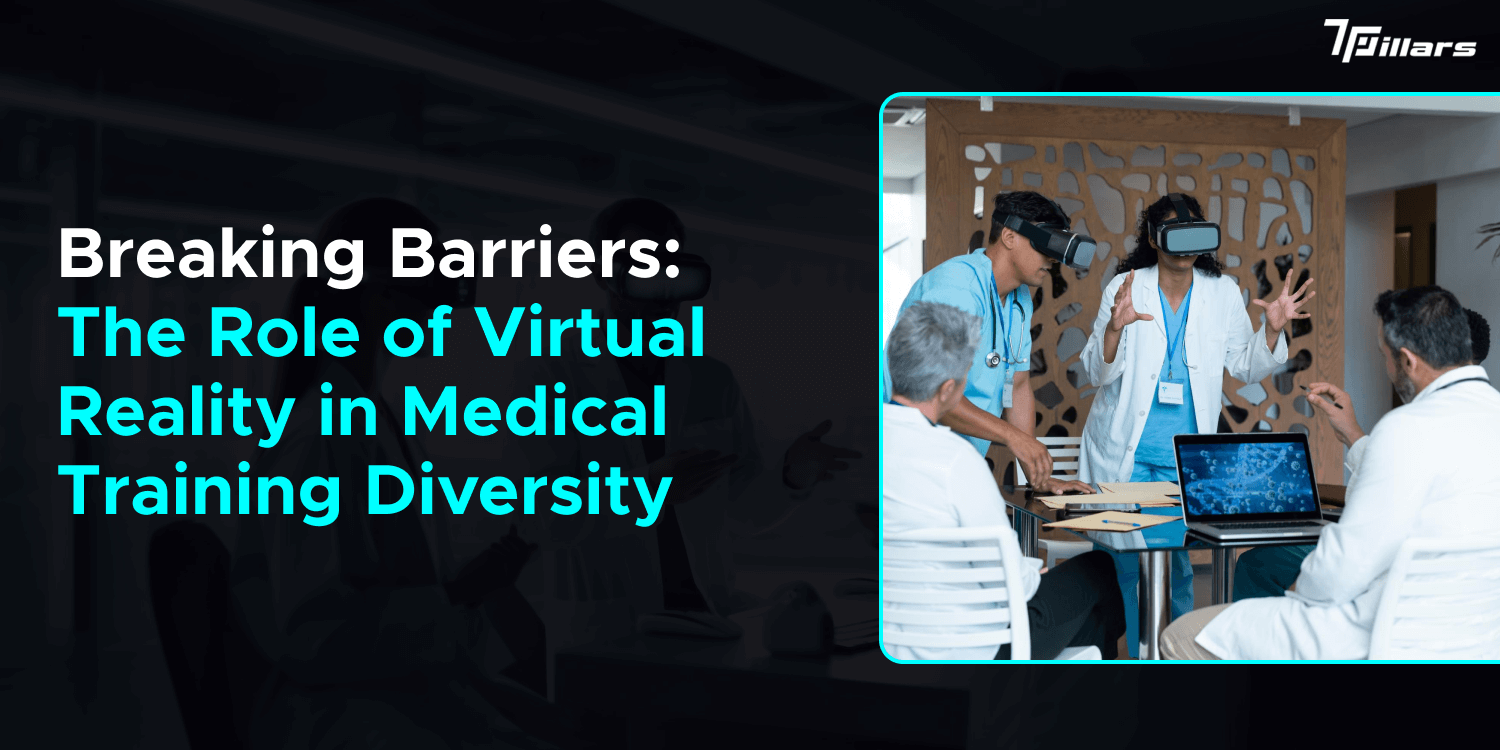
Of course, medical training is the epicentre of innovation today when technology is, for the first time, altering the way we conceptualize how things are possible. Aspirant doctors no longer rely on textbooks and lectures as their primary tools; instead, they can learn through lifelike simulations that connect theory to practice. Imagining wearing a VR headset and going into an operating room, with sounds of surgical instruments and tension emanating through the beating of the patient’s heart, is not science fiction but the new reality of medical education.
This will change how future health professionals are trained and sharpened in their practice using VR technology. Good foundation, less hands-on experience usually is given to trainees through old methods.
This simulates complex surgical procedures multiple times in no-risk environments to gain expertise and build confidence and expertise without endangering a patient’s safety during emergencies or while undertaking complex surgeries. VR training covers critical areas, starting from managing intricate surgeries and scenarios during an emergency, which is what no other method provides.
Beyond the Classroom: How VR is Revolutionizing Medical Training
However, the benefits of VR extend beyond knowledge acquisition. VR will foster much critical thinking and decision-making under stress as subjects practice handling challenging situations in a controlled way. This opens up even more opportunities for retention: students will remember what they have learned the moment they are needed most. Lastly, VR can tailor training to different learning styles, offering tailored routes which adapt to each trainee’s own pace and preferences.
In the stages of integration of VR in medical training, we will understand different impacts through surgical procedures and interaction with a patient. This paper also examines the challenges which come with the implementation of such technology in learning institutions and innovative solutions that are under development to overcome such challenges. There is massive potential in this technology for transforming medical training, thus better preparing the healthcare professional of the future to meet the complex needs of modern medicine.
So, join us on this journey to discover the exciting aspects of VR technology developments related to the future of medical training. Whether it’s a student, an educator, or just an interested observer watching the intersection of technology and health, you do not want to miss this discovery of how virtual reality is changing the landscape of medical education forever.
What Is Virtual Reality-
Virtual reality is an immersion technology which allows people to be manipulated in a three-dimensional world using specialized equipment. The media is quite different from all the other forms of presentation since it aims to involve the users interactively to enable them to believe they are within their physical space.
The basis for all VR experiences includes head-mounted displays, which give the viewer high-resolution visuals with head-tracking, so there is a sense of depth and space. Sometimes, these devices may come with other accessories, like motion sensors and controllers, that can be used to place objects and help navigate one’s virtual surroundings in the same way as one would in real life. This interactivity separates VR from other forms of digital entertainment.
In gaming, VR lets players enter rich, detailed worlds and directly experience adventures, which makes users highly engaged and emotionally enhanced. Applications such as “Beat Saber” and “Half-Life: Alyx” epitomize how VR can reset the game experience because what might be impossible in any conventional format.
Education uses VR to create an immersive learning environment where students can visit historical sites, perform virtual science experiments, or practice more realistic simulation scenarios.
With this hands-on approach, retention and understanding will, in general, increase even with rather complex subjects-for example, medical students can test surgical procedures without risk before practising them on actual patients. Hire a virtual reality app development company to help you integrate this innovative technology into your healthcare organization.
Experts are utilizing this potential of VR to treat patients afflicted with a variety of disorders, including PTSD, anxiety, and phobias, within therapy. Controlled exposure therapy in a controlled environment helps the patient slowly confront and overcome the very basis of the fear one harbours.
The strength of the ability to make safe scenarios customizable is one of the best values that VR adds to the mental health professionals’ arsenal.
Although VR has several advantages, there are still some challenges associated with it, such as high cost, technological limitations, and motion sickness. The seamlessness and widespread nature of the VR experience will likely be attained through further development and advancement of the technology, particularly in visuals, user interface, and accessibility.
In short, virtual reality is a world-shaking technology that destroys the confines between the digital and physical worlds.
With entertainment, education, or therapeutics as social powers, VR is not just here today and gone tomorrow but is a revolution to re-cast the future of human interaction with technology. As it becomes more accessible, its impact on society will probably grow for new possibilities to explore and understand.
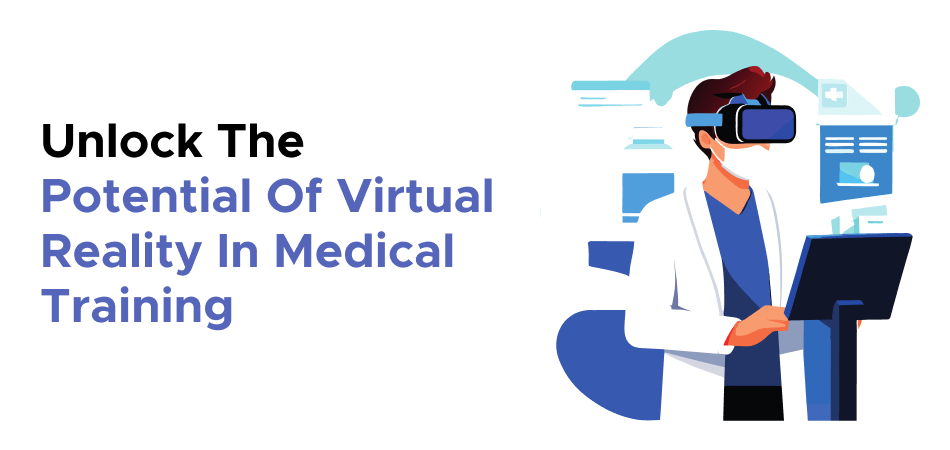
Growth Of VR In Medical Training In Australia-
The virtual reality technology used in the training of medical personnel is revolutionizing the face of healthcare education in Australia at an exceptional speed. This new technology is giving way to new learning, practising, and refreshing of their skills, but for future health workers, better skills in the care provided to patients make this a tool for improving patient care.
First, learning is made more accessible and immersive. The traditional approach is theoretical knowledge and some interactive training. VR addresses this gap by providing visual simulations of an actual clinical situation, allowing students to learn in lifelike environments without the risks of actual processes. For instance, students can practice surgeries, emergency response, and patient communication in a controlled environment, thus making the students more confident and competent. Collaborate with a leading virtual reality app development company to help you invest in the booming industry.
VR is part of the curriculum in various Australian universities and medical schools. The University of Queensland and Monash University have pioneered modules on medicine from multiple dimensions. These programs hone the technical skills of the student and critical thinking capabilities with decision-making.
The concept of VR supports different learning styles in medicine. Students who are not well-prepared through the traditional mode of studying feel that they would better enjoy their learning through simulation and that whatever needs would be filled about the learning process would make it both enjoyable and effective. However, with VR, training programs for healthcare providers can range from recently admitted novices to professional practitioners intent on refreshing their knowledge or acquiring fresh ones.
Training sessions were also limited, which accelerated the take-off of VR technology during the pandemic. Institutions such as hospitals and education centres applied VR to preserve training standards with minimal means of implementing social distancing. This evolution proved VR efficiency and led to its expansion into further uses in the future.
Industry cooperation is also propelling VR up the growth curve in medical training in Australia. Cooperation between learning institutions and technology companies stimulates innovation, which finds its way into the development of advanced applications for medical education. This co-operation ensures that the tools that comprise the provision of training keep up with the new developments in medicine.
Therefore, it has been concluded that VR in medical education in Australia has brought a phenomenal change in Australia’s health education. With its immersive, risk-free learning environment, VR supports the development of a healthcare professional who will make a big difference in patient outcomes.
With that, this capability can expand over time since technology continues to advance, thereby setting the course towards the future direction of the healthcare education system in the country.
-
Adoption Rates:
According to recent research, the use of virtual reality in Australian medical schools has gradually increased from 30% five years ago to over 70%.
-
Market Growth:
In Australia, the VR healthcare market will register a CAGR of close to 30% over the next five years, as it will be fuelled by the demand for new training approaches.
-
Student Engagement:
Evidence suggests that comprehensive VR training may raise students’ attendance by up to 90%, as students are more likely to devote their time to engaging with training that uses virtual reality in education.
-
Skill Retention:
Studies show that doctors trained using virtual reality methods remember facts and techniques with 30% more retention than traditional training procedures.
-
Simulation Use:
These surveys showed that 80% of workers in the medical field are more confident of their actions when performing a simulation in real life because of VR simulation.
-
Emergency Training:
Disregard that VR applications for emergency medicine can take up to 50% less time for training than traditional models.
-
Partnerships:
In the last two years, universities and technology companies have formed over 50 engagement partnerships to develop virtual reality training for the healthcare industry.
-
Cost Reduction:
A survey from a few institutions claims that VR simulation training is 40% less expensive than traditional training since it uses fewer materials and resources
-
Patient Safety:
Another study found that Medical institutions that adopted Virtual reality for training surgeons recorded a 25% reduction in medical mistakes among the learners.
-
Global Context:
VR adoption in medical training is one of the most enacted globally, rendering Australia among the five leading countries using VR technology for healthcare training.
These figures clearly show the extent of the popularity and increase in the use of VR in medical training in Australia in a very short period, with a high possibility of changing the face of healthcare training.
What Is VR In Medical Training?
Virtual reality has revolutionized numerous industries for years, and the healthcare sector is no exception. For medical training, VR is changing how experts and trainees learn and practice complicated procedures. They can practice complex scenarios, such as surgical operations or patient interactions, through immersive simulations that reproduce them in a controlled, risk-free setting.
This training improves their confidence and capability before they face actual patients. Collaborate with a leading mobile app development company to help you study your competitor’s work and users need to ensure your app doesn’t fail once launched.
VR is credited primarily to diagnostics. Healthcare providers can better comprehend the complexity of conditions by formulating accurate visualizations of patient data. Such visualization provides a much larger view of a patient’s anatomy and pathology, where professionals can point out health issues much faster and more accurately. For example, pre-operative planning may involve complex structures visualized by VR.
Using virtual reality (VR) to create more engaging and interactive experiences can aid in patient education and help them comprehend their health conditions better. Owing to technological advancements in virtual reality, the application and use of this technology in healthcare will expand, making patient care and medical training more efficient and accessible than before. As a result, patients will probably comply better concerning enhanced health.
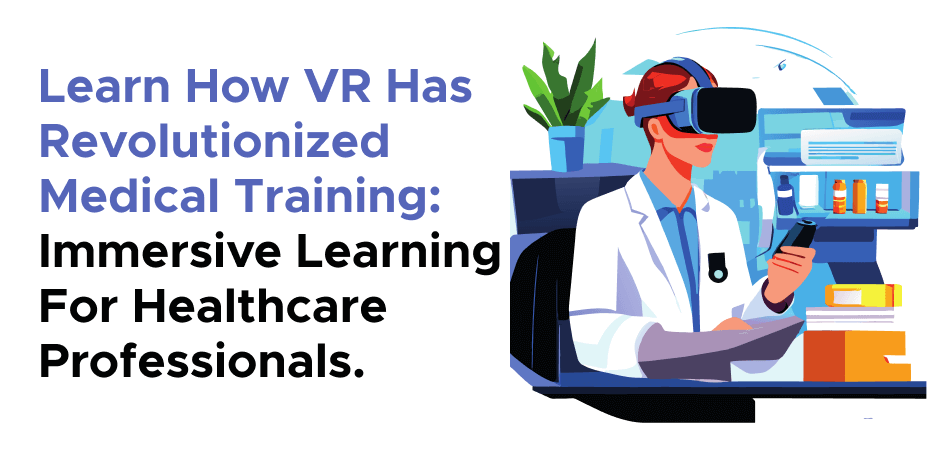
Evolution Of VR In Medical Training-
VR finally became a part of the health environment during the 1990s for simple surgical simulation. Those applications represented a unique opportunity for surgeons in training to try a broad list of procedures in a virtual environment and learn many skills without the risks involved with actual operations.
The technology, however, had its weaknesses, including poorly realized graphics and clumsy hardware, which did not contribute to its greater effectiveness or broader spread. A reputable Android app development company can help you understand how the technology evolved to become what it has become.
Fast-forwarding to the last thirty years, the face of VR in the health sector has transformed dramatically. Improvements in technology resulted in a more engaging and interactive virtual reality experience in addition to offering a high-value experience. Current systems achieve high-definition graphics and ergonomic tools to render the best and most engaging user experience possible. Such advances positioned VR as a valuable asset within the healthcare sector because it can realistically simulate complex procedures.
Other software developments have further influenced this transition. Implementing augmented reality and the latest VR trends has made patient interaction and training methods relatively easier.
Today, new VR medical training software enables students and experts to witness real-life, hands-on experience in a simulated setting, filling the gap between learned theoretical knowledge and actual practice. This integration of VR and AR continues to revolve around medical training and patient care, promising a bright future in health education and practice.
Challenges In Medical Field-
The next generation of health professionals is prepared for all healthcare circumstances through rigorous training in medicine. Nonetheless, several problems can affect both trainees and trainers. Among the most typical challenges encountered during medical education are the following:
1. Time Management and Workload
The medical students’ and residents’ lives are wrapped in heavy timetables of intense studies, clinical rotations, and personal responsibilities. There seems to be a need for inordinate amounts of time spent in clinical settings that tend toward developing burnout and stress. For many trainees, it might be hard to combine the instructional load with their well-being.
The medical field provides high-stakes environments for trainees; thus, they encounter suffering, death, and challenging patient interactions daily. Emotional strength to cope with all this is an essential yet challenging component of training. Students may experience feelings of inadequacy or compassion fatigue, which can detrimentally affect their mental health and capacity to care.
2. Cost
For many trainees, the biggest obstacle is the cost of medical school. Tuition fees and living costs continually rise, and the pressure of having a roof overhead reduces learning time. Trainees who graduate with substantial debt have to pay their way by forsaking independence, comfort, and conducive work conditions in the name of career choice at the expense of job security.
3. Access to Quality Mentorship
Mentoring is a beneficial practice in medical education that involves advising trainees on support and career advancement. However, this advantage is not equally available to all trainees. Often, due to the scarcity of experienced faculty, especially in certain specialities, the students and residents are not in a position to continue their growth and learning process appropriately.
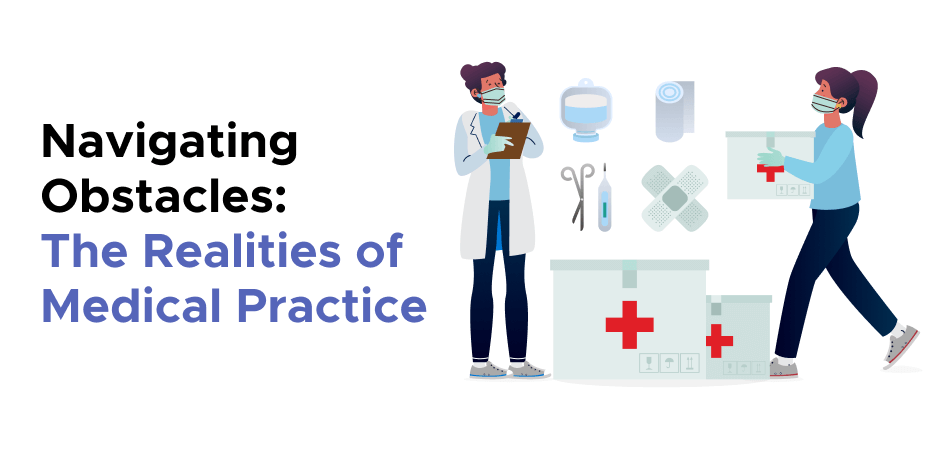
4. Standardization vs. Individualization
Standardized curricula might fulfil the general baseline needs for knowledge and skill acquisition but fail to provide scope for accommodating individual learning styles or diverse needs in a trainee population. Creating the required homogeneity within a standard but personalized training curriculum can be challenging and may lead to inequalities in learning outcomes.
5. Technological Adaptation
While health care is now more technological, the medical trainee needs to be updated with the various tools and platforms that medicine uses in its application. At the same time, the ever-changing and overwhelming nature of new technologies often means an overwhelmingly large number of medical trainees who may not fully understand their use of digitized tools. This only translates to constantly updating based on medical technology’s constant evolution, requiring one to continue learning and adapt accordingly.
VR In Medical Training And Its Benefits-
In the health industry, the adoption of VR has been a transformative technology. Practically speaking, the uses of virtual reality widely range between enabling improved patient care and training in medical practices. By participating in simulations, virtual reality (VR) can provide patients with captivating experiences that help them manage pain, lessen anxiety, or achieve the right kind of recovery.
Through VR technology, medical students and professionals can practice complicated procedures in a controlled environment that would otherwise put them at risk in actual surgeries, thus helping them gain added skills and confidence. With VR technology, remote consultations are now possible, expanding access to care, especially to underserved populations. In general, VR is changing everything in health care provision and experience.
1. Real-Time Feedback-
Would you not love to use virtual reality technology as a medical trainee to learn how to do general operations and complex surgeries? You could learn new techniques without endangering patients’ lives. The best part about integrating VR in medical training is the timely feedback it provides to the medical trainees to help them know where they want wrong or what they can improve to achieve better results.
It enables them to fix their wrongdoings instantly on their virtual patients and learn from their mistakes, thus ensuring they won’t repeat them on their actual patients. It helps reduce mortality rates. Real-time feedback enables trainees to communicate with their patients effortlessly without fearing their reactions to the minor mistakes they make during the procedure. Additionally, VR medical systems and training assist professionals in monitoring several critical performance indicators.
2. Increased Retention-
Would you not be urged to finish your training before entering the surgical field if you could conduct surgeries with little to no error? Over time, the amount of mishaps occurring on the operating table has decreased significantly, with multiple trainees and medical professionals admitting to being more confident after practising complex surgeries through virtual reality.
A recent study on laparoscopic surgery training found that 87% of participants experienced an increase in accuracy following the application of virtual reality technology in the medical industry. Australian medical universities and labs are integrating virtual reality technology into the curriculum to help students gain experience in complex surgeries.
3. Improved Learning Experience-
Although the theory is the primary competing method for acquiring medical knowledge, experience contributes to students’ mastery of knowledge to a greater extent. Virtual Reality (VR) is another advancement in healthcare that enables medical students to practice intricate tasks on simulated patients.
Donning intricate procedures allows the students to hone their abilities, establishing competency that ensures minimal mistakes once they get to the actual world. In addition, using VR in education helps students combine knowledge with practice and get a more profound understanding of concepts. This results in the training of applicants for working conditions in medical practice and the development of a more effective educational process.
4. Safe Simulations And Procedures-
Another benefit of integrating virtual reality into your curriculum is that it provides trainees and medical professionals a safe environment to practise their skills on patients who act like patients with needs and demands.
From surgery to conducting an examination and reacting to emergencies, Virtual Reality simulations allow learners to fail without costing them anything. Such safety leads to exploring mistakes and growth in confidence and skills before they deal with the patients. Virtual Reality has provided the medical industry a boon by allowing trainees and interns to practise endlessly to improve their skills without risking lives.
5. Standardized Training Experience
It eliminates geographical differences in training standards and opens equal access to quality-simulated exercises for all learners across institutions regardless of their resources. This leads to the point that medical trainees in big and small cities or other regions can experience the same educational material and cases, which means equal opportunities.
The kind of consistency it brings is fairness to the practitioners and all the medical professionals who should be trained similarly. It can enhance healthcare delivery performance and foster an efficient understanding of the current benchmarks within the anticipated healthcare system.
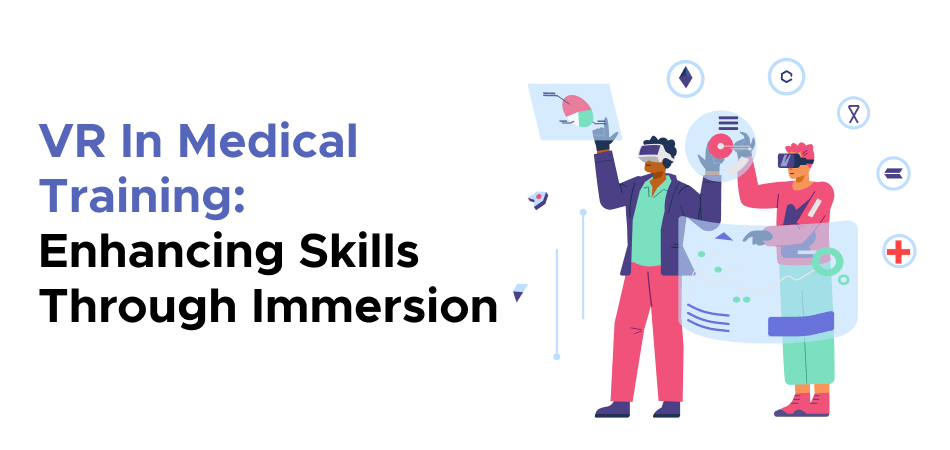
6. Improved Patient Interactions-
Virtual reality has done wonders in helping medical trainees improve their bedside manner by permitting students to rehearse interpersonal communications in lifelike simulators, thus allowing them to work through multifaceted feelings, strengthen their interpersonal skills, and gain insight into the patient’s condition.
This technique helps raise the next generation of doctors and medical staff to become empathetic towards patients’ pain and needs without judging them for their demands when they are in pain.
7. Engagement and Motivation
Students’ participation is maximized by virtual reality’s participatory nature. It makes learning more vivid and lively. With Gamified elements such as scoring, achievement levels, and rewards, VR motivates people to do things they have never done before and even conquer challenging content.
This intensive engagement promotes a better understanding of the material and perseverance because someone is driven to improve their score and move to the next level. It means that higher interaction leads to better retention and drives the experience of learning from the traditional perspective into an enjoyable yet effective one.
Medical Training and Virtual Reality: Significant Applications
Virtual reality in medicine and surgery is on the verge of revolutionizing several applications in training and treatment. It will be well suited for medical students and professionals due to immersive simulations that allow them to practice complex procedures risk-free. It will enhance skills and confidence. VR can further aid in patients’ treatment by controlling pain and anxiety by distracting such patients during the procedure.
Moreover, it provides remote consultation so specialists can guide surgeries from afar. It aids in patient education, and patients are thus capable of seeing the conditions and treatments themselves, which might further enhance understanding and compliance.
1. Physiology and Anatomy
Human anatomy and physiology remain compulsory foundational courses and at the same time, challenging courses in most schools and colleges offering medical programs. It provides three-dimensional and lifelike models that enable the learners to navigate, manipulate and consequently undertake analysis of various physiological systems and organs. While traditional methods involve essay practical, ethical problems can arise; through virtual dissections, students get practical experiences without complication.
These virtual representations of human organs, body systems, and functions are better for learning since they improve comprehension and retention. To prepare for increased clinical practice and patient care, students can thus comprehend some complex concepts with ease.
2. Surgical Training-
Since its invention, virtual reality has produced gifted physicians and medical trainees, saving millions of lives. Virtual reality (VR) has helped the medical field in education by transforming the practice of all surgical procedures into safer and more efficient methods. Of the identified technologies, VR simulation tools bring students in close touch with appliances that mimic real-life situations, enabling practice without having to experiment on patients.
These models allow learners to practice complex operations multiple times accurately with fewer mistakes. Since students master these roles with actual surgeries through simulations, they are sure of themselves and are capable of handling actual operations better.
3. Treating Mental Illness-
Currently, VR is used as a tool complementary to traditional work methods and as an independent technique in the therapy of patients. Programs like Bravemind and Limbix are creative ways of incorporating virtual reality elements in treatment programs to assist patients with trauma and anxiety disorders, get exposure to feared stimuli and engage in timely mindfulness exercises.
These tools enable the patient to face and overcome their phobia in a safe environment to effect recovery. During the current pandemic, VR proved beneficial by offering people a chance to seek psychological help without needing physical contact. Mobile technology has demonstrated efficacy in augmenting patient participation and facilitating rehabilitation throughout challenging periods in mental health support.
Limitations Of Virtual Reality-
Nonetheless, as compelling as current trends and technologies of VR have been in future-proving the prospective medical education and patient care—there is one caveat: VR restraints. A difficulty to tackle here is that implementing VR within an institution requires not only equipment that can be expensive but software as well.
Further, the technology needs adequate technical support and training for efficient use in its application. Users too can suffer discomfort, like motion sickness, which may limit the duration of usage. Finally, VR tends to lack real-life scenarios to the extent that realism is a pivotal determinant of learning, again restricting the extent to which experiential learning and clinical practice can occur.
1. Accessibility And Cost-
One of the main issues that arise while using VR with medical training is the high costs of the associated software and hardware. Software programs for VR simulation and headsets can be costly, and few academic establishments can afford to acquire them for student learning.
This financial factor acts as a barrier by providing inadequate access, minimizing students’ and professional’s ability to gain benefits from engaging training environments. There may be limitations on the development of VR programs in the future, as well as talent development, improved patient outcomes, and technological improvement in healthcare facilities.
2. Technical Issues
Technical problems in software and hardware are primary issues of virtual reality training in healthcare and treatment. These technical challenges sometimes bring about interruptions that significantly interfere with the learning process, besides affecting the efficient delivery of patient care.
For example, unanticipated system failure during a simulation may offset timely training, frustrating the trainees. To avoid these challenges, one must work with an experienced healthcare app development company. These collaborations can ensure the dependability, regular upgrades, and upkeep of VR apps, increasing VR’s overall effectiveness in the medical sector.
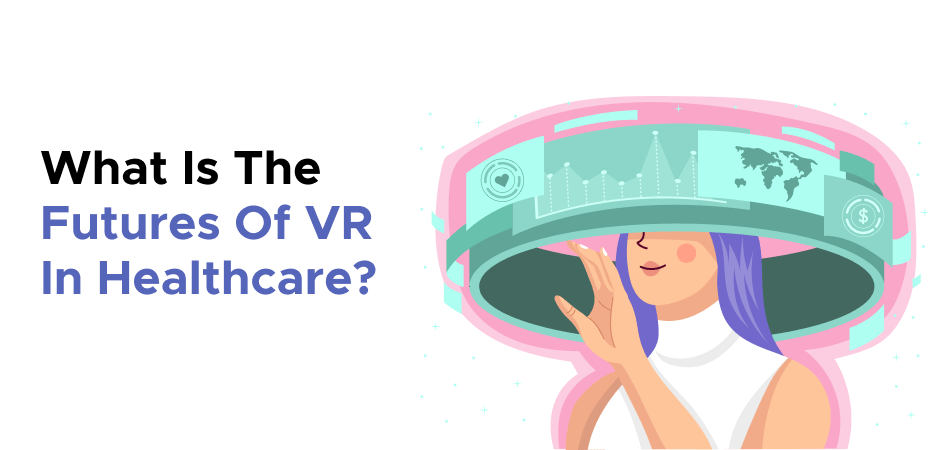
Future Of VR In Healthcare-
1. Expansion–
Extremely promising remains a perspective for developing VR in the medical field, allowing training curricula in different countries to be improved. In the United States, for example, several institutions have started introducing pilot programs that sought to test the viability of VR in medical education. For example, Stanford University is using VR technology to teach students in Kenya about human anatomy more sensibly.
At the same time, many institutions are engaging technology firms to improve the development of medical web applications. In parallel, several developing applications for Dialectical Behavior Therapy are available to provide healthcare workers with powerful tools for improved patient treatment and training. This technological integration could impact medical education and the practice of medicine significantly.
2. Integration With AI-
In medical education, integrating virtual reality (VR) and artificial intelligence (AI) presents a novel approach to enhance learning effectiveness. AI technology can remarkably enhance VR programs, which help to overcome students’ learning deficits during their studies in medical schools. AI in VR entails dynamic learning that is as close to clinical practice as one can get since the program can change depending on how the user acts and respond to their actions in real time.
These collaborations would enable the development of sophisticated medical device software for attendants and provide the students with accurate knowledge and skills in medical practice.
Conclusion-
Looking back on our study of virtual reality (VR) in medical education, we can see that this innovative technology is changing healthcare education, not just a fad. Virtual reality (VR) presents unmatched chances for immersive education, enabling medical professionals and students to participate in lifelike simulations that improve their clinical judgment, patient relations, and clinical skills. With virtual reality (VR), learners can make mistakes and learn from them without fear of the terrible consequences that could occur in real-life scenarios.
The Australian mobile app development company 7 Pillars can assist you in realizing the complete range of advantages virtual reality can provide your healthcare institution.
However, integrating VR into medical training is not without challenges. Issues, like cost, the need for proper infrastructure, and the necessity for educators to adapt to new teaching methods must be addressed. Yet, as technology advances, we can expect these barriers to diminish.
Our team at 7 Pillars can help you build your dream virtual reality-integrated app within your budget while ensuring the end products align with your vision.
The future of medical training is intertwined with virtual reality. By embracing this technology, we can cultivate a new generation of healthcare professionals who are better prepared, more confident, and more capable of delivering high-quality patient care.
As VR continues to evolve, so will its potential to enhance medical education, thus benefiting practitioners and patients alike. The journey has just begun, and the possibilities are as limitless as the technology.
So, if you are an entrepreneur or a healthcare organization owner looking to invest in integrating virtual reality into your app, connect with our skilled team at 7 Pillars, a leading mobile app development company today.








